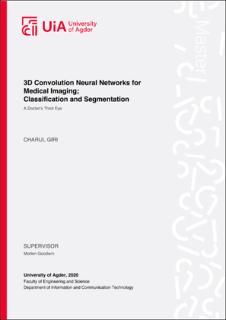| dc.contributor.author | Giri, Charul | |
| dc.date.accessioned | 2020-10-23T09:03:59Z | |
| dc.date.available | 2020-10-23T09:03:59Z | |
| dc.date.issued | 2020 | |
| dc.identifier.citation | Giri, C. (2020) 3D Convolution Neural Networks for Medical Imaging; Classification and Segmentation : A Doctor’s Third Eye (Master's thesis). University of Agder, Grimstad | en_US |
| dc.identifier.uri | https://hdl.handle.net/11250/2684703 | |
| dc.description | Master's thesis in Information- and communication technology (IKT591) | en_US |
| dc.description.abstract | In this thesis, we studied and developed 3D classification and segmentation models for medical imaging. The classification is done for Alzheimer’s Disease and segmentation is for brain tumor sub-regions. For the medical imaging classification task we worked towards developing a novel deep architecture which can accomplish the complex task of classifying Alzheimer’s Disease volumetrically from the MRI scans without the need of any transfer learning. The experiments were performed for both binary classification of Alzheimer’s Disease (AD) from Normal Cognitive (NC), as well as multi class classification between the three stages of Alzheimer’s called NC, AD and Mild cognitive impairment (MCI). We tested our model on the ADNI dataset and achieved mean accuracy of 94.17% and 89.14% for binary classification and multiclass classification respectively. In the second part of this thesis which is segmentation of tumors sub-regions in brain MRI images we studied some popular architecture for segmentation of medical imaging and inspired from them, proposed our architecture of end-to-end trainable fully convolutional neural net-work which uses attention block to learn the localization of different features of the multiple sub-regions of tumor. Also experiments were done to see the effect of weighted cross-entropy loss function and dice loss function on the performance of the model and the quality of the output segmented labels. The results of evaluation of our model are received through BraTS’19 dataset challenge. The model is able to achieve a dice score of 0.80 for the segmentation of whole tumor, and a dice scores of 0.639 and 0.536 for other two sub-regions within the tumor on validation data. In this thesis we successfully applied computer vision techniques for medical imaging analysis. We show the huge potential and numerous benefits of deep learning to combat and detect diseases opens up more avenues for research and application for automating medical imaging analysis. | en_US |
| dc.language.iso | eng | en_US |
| dc.publisher | University of Agder | en_US |
| dc.rights | Attribution-NonCommercial-NoDerivatives 4.0 Internasjonal | * |
| dc.rights.uri | http://creativecommons.org/licenses/by-nc-nd/4.0/deed.no | * |
| dc.subject | IKT591 | en_US |
| dc.title | 3D Convolution Neural Networks for Medical Imaging; Classification and Segmentation : A Doctor’s Third Eye | en_US |
| dc.type | Master thesis | en_US |
| dc.rights.holder | © 2020 Charul Giri | en_US |
| dc.subject.nsi | VDP::Teknologi: 500::Informasjons- og kommunikasjonsteknologi: 550 | en_US |
| dc.subject.nsi | VDP::Matematikk og Naturvitenskap: 400::Informasjons- og kommunikasjonsvitenskap: 420::Simulering, visualisering, signalbehandling, bildeanalyse: 429 | en_US |
| dc.source.pagenumber | 92 | en_US |

